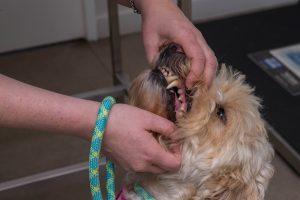As you can see from the picture, food, hair and bacteria can get stuck between the small gap of the two teeth, which then causes discomfort and gingivitis. We recommend having the baby teeth extracted sooner rather than later. Many people choose to do this when their pet is in for neutering, to reduce the need for a second anaesthetic.
Bleeding Gums
Due to the bacteria in the plaque and tartar, the gum become inflammed and sore (gingivitis). When we scale this off the gums often tend to bleed.
As long as good home care is carried out afterwards, the gums can heal which makes the tooth more secure.
Plaque and Tartar
When plaque continues to build up, it forms tartar. This is a thick, hard coating of bacteria. It doesn’t smell very pleasant which adds to your pets’ halitosis (bad breath). It also starts to affect the gums by causing infection and inflammation (gingivitis).
Root Exposure
When the gums recede, it exposes the tooths’ root. The bacteria from the plaque and tartar can then work its way into the blood stream. In serious cases it can cause organ damage such as liver and kidney failure.
Overcrowding
Over crowding of the teeth can be quite common in smaller breeds of dog, but can happen to any size of dog. There can be all sorts of reasons for this, from the deciduous teeth not falling out when they should, causing the adult tooth to rotate when erupting to the dog purely having a jaw too small to squeeze all the teeth in!
This doesn’t necessarily cause issues, but it can potentially cause problems depending on the severity. In the worst case scenario, some of the teeth may need to be extracted.
Scale and Polishing
The only way we can get the plaque and tartar off the teeth, is to scale it off.
Unfortunately this involves your pet having to go under an anaesthetic.
Our nurses are fully qualified to perform this procedure. Once your pet is asleep, we can then begin scaling all the plaque and tartar from the teeth. This takes quite a while as the tartar is glued onto the teeth, and we have to clean the front, back and inside of the tooth very thoroughly.
Once this is done, the vet can then check the teeth for any signs of decay and whether any extractions are needed.
The final step is to polish the teeth. We do this to buff out any microscopic grooves left on the teeth through scaling. This helps to prevent further build up of plaque, and makes your pets breath smell much more pleasant!
Extractions
We do everything we can to save the teeth but sometimes extractions are unavoidable.
Once this dog had his teeth scaled, all his lower incisor teeth were wobbly due to severe gum recession from the bacteria in the tartar eating away at it.
The gums tend to heal relatively quickly, and he is now a much happier dog.


